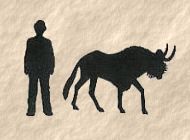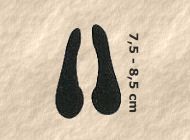 |
 |

Size

Footprint
|
Close this window to go
back to the previous page |
|
Description
|
An ox-like animal with unusual horns, a beard
and hair on the nose. The colouring is darkbrown and the horse-like tail is
almost white. The calves are a uniform light brown colour. The back slopes
downwards. Both sexes have horns. The Black Wildebeest can be distinguished
from the Blue Wildebeest with its conspicuous white tail, smaller build and
horns with curve forward. |
|
Sexual dimorphism |
Females are smaller than males |
|
Habitat |
Open grasslands with sufficient water |
|
Habits |
These animals occur naturally only in South
Africa. They form herds of 6 to about 50 individuals consisting of adult
males, females and juveniles, or adult males only. The usually graze in the
early morning or late afternoon, resting at midday. In cold weather they
graze any time. Sometimes they are seen kneeling while they feed. During the
mating season males are very aggressive when they protect their territories
but serious fights seldom occur. |
|
Voice |
A loud snorting bellow and "ghe-nu" sound
by territorial males. |
|
Breeding |
A single calf is born during November to
December after a gestation period of ± 8½ months |
|
Food |
Mainly grass and sometimes karoo bush. |
|
Mass |
♂
180 kg
♀ 140 kg
|
|
Life expectancy |
± 20 years |
|
Length of horns |
Average ± 52 cm
Record 74,61 cm
|
|
Enemies |
None |
|
Also known as |
Swartwildebees (Afrikaans)
White-tailed gnu |
|
This
site is best viewed at 1024 X 768
Please report any problems to the Webmaster
Copyright © CoZania October 2004 |



